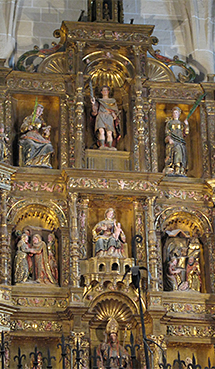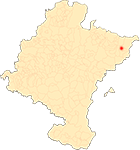Route through the Roncal altarpieces
By Ricardo Fernández Gracia
Main altarpiece of the parish church of Isaba
The main altarpiece of Isaba is the work of Miguel de Gárriz, a master who is gradually taking shape and is no longer a practically unknown name. He was a sculptor properly speaking, since in the documentation he continually appears as an image maker, whose personality is certainly blurred in the history of our Renaissance plastic arts. His figure must be vindicated as one of the masters with the capacity to carry out important projects in the second third of the 16th century, from his workshop established in the capital of Navarre.
The news of his intervention in Isaba, provided by the Catalog Monumental de Navarra, was an oral communication of researcher Vicente Villabriga and today we can corroborate it with the abundant data of a process preserved in the file General de Navarra (AGN. Procesos, núm. 146063).
The commitment to make the main altarpiece of Isaba was preceded by other notable commissions, such as the bust of Saint Ursula in the cathedral of Pamplona in 1534. He had a workshop in Pamplona, was married to María Jiménez de Cascante, worked among other altarpieces in the parish of Olloqui (1541), for the archdeacon Remiro de Goñi in the Hospital (1551), the parish of Orísoain that has been preserved and that we document (a. 1565), and appraised the old altarpiece of the Rosary of the Dominicans of Pamplona, work of Miguel de Espinal in 1562. His widow claimed, in 1568, 80 ducats from those of Donamaría, the remainder of 120, for the work of an altarpiece for the parish church of that town. As Eduardo Morales has pointed out, the documentation refers to him as maese, which is not the case in his time but with Miguel de Espinal and Juan de Anchieta, which indicates his position of preeminence within the official document. As in other cases of artists active in the second third of the century, he evolved from more decorativist positions to the use of more classical motifs and Structures , as can be seen in the altarpieces of Isaba and Orisoain, slightly later and the work we document by the artist in these lines, dated around 1570 and which must be brought forward by about a decade.
The Isaba altarpiece, apparently the most ambitious of his projects and which its author described as "very good", was made position in 1555, to be finished in five years. In August 1560 and agreement with the aforementioned deadline , the carver Juan de Villarreal and the sculptor Miguel de Espinal proceeded to its appraisal. Both evaluated the whole -altarpiece, imagery and tabernacle- at seven hundred ducats, an amount they calculated for the labor invested in the piece, and imposed on Gárriz the obligation to make the dust covers because they understood that the aforementioned elements were going to provide more proportionate dimensions to the altarpiece. The decoration of the same ones would incorporate "pendants of fruit leaves in the Roman style and the leaves well bulging", in tune with the uses of those motifs in those moments that always gained in dimensions and fleshiness. In 1565, an old Miguel de Gárriz and with lack of report, took to court those of Isaba for the debt that amounted to 553 ducats and 35 tarjas, since he had only received 146 ducats and 15 tarjas. The contract could not be provided as test, since the master could not locate it, but it was signed in Pamplona in the presence of Bishop Moscoso, one of the Pamplona prelates who spared no effort to modernize the temples and their furnishings. Numerous data of how the artists were paid in the 16th century appear in the testimonial evidence. We will only point out the role played by the President don Lorenzo Périz, who assured the sculptor, when he began work on the altarpiece, that he was a creditor of the church for 800 ducats and that he would be the first to be paid. In a letter from the aforementioned President we read: "It pains my soul that Master Miguel Gárriz, the good old man, writes so much grief in the debt that the church of Isaba owes him ...., there is no other particular thing, that Master Miguel has been deceived, that I speak clearly, that he will be paid and I will be the first to be paid and if I die, then I will be forgotten...".
The gilding and polychromy of the altarpiece were entrusted, in 1583, to the Palencia painter from Becerril de Campos, Simón Pérez de Cisneros, who was owed more than twenty thousand reales in the year 1608, as stated in his own will. The names that appear in inscriptions as responsible for the gilding: FECERUNT LUCERE -they made it shine- can be identified: Juan Carrica with a beneficiary of the parish and Pedro Jorge with the abbot of the parish. The content of the lucere of the mentioned registration must be related to the medieval aesthetics of Saint Thomas who considered beautiful the things that please the eye: quia visa placent, with three conditions: integritas, consonantia et claritas (sharpness, splendor, luminosity, brilliance, clarity and brightness .....).
The piece adapts aesthetically to the postulates of the great works of the second third of the century, in its decorative phase. Structurally it is organized with a bench with niches, two large bodies divided into five sections, trimmed with a wainscot and an attic. Balusters, fluted columns with the lower third decorated, temples with figurines and decorative friezes of different quality in which children with bows, trophies, cartouches, skulls, phylacteries, warriors with mermaid tails, eagles and cupids are the protagonists of the piece with a great load of decorativism.
The sculpture, of unequal invoice and style, obeys to the confluence in his workshop of the tendencies - Aragonese, Castilian and Flemish - prevailing at that time in the Navarrese plastic arts and very particularly in the Pamplona workshops. The iconography presents on the bench sculptural groups dedicated to the Passion, in the first body, lumps of diverse saints of devotion in the town (San Pedro, San Gregorio, the titular San Cipriano, Santo Obispo and San Marcos), in the second one scenes of the life of the Virgin in groups (Annunciation, Visitation, Virgin with Child, Nativity and Nativity of the Virgin Mary), Virgin and Child, Nativity and Epiphany) and finally, in the attic other saints (Santa Engracia, San Felix and Santa Quiteria) topped by an expressive Crucified, aesthetic to which the rest of the sculpture of the altarpiece belongs, although without the exaggerations of that current.
Parish archives of Garde, Vidángoz, Isaba, Uztárroz and Roncal.
file Diocesan of Pamplona. Processes
file General of Navarre. Roncal Notary's Office and Processes
ARDANAZ IÑARGA, N., La catedral de Pamplona en el siglo de las Luces. Arte, ceremonial y cultura, Pamplona, doctoral dissertation sustained at the University of Navarre, 2011. Vid. http://hdl.handle.net/10171/20480
BOLOQUI LARRAYA, B., Escultura zaragozana en la época de los Ramírez 1710-1780, Madrid, Ministerio de Cultura, 1983.
CHOCARRO HUESA, M., "El obispo Juan Rena, mediador y mecenas artístico de la catedral de Pamplona", Príncipe de Viana, 256 (2012), Issue dedicated to: programs of study sobre el Patrimonio Cultural y las artes en Navarra en torno a tres hitos 1212-1512-1812, (coordinated by Ricardo Fernández Gracia), pp. 587-601.
CLAVERÍA ARANGUA, J., Iconografía y santuarios de la Virgen en Navarra, vol. I, Madrid, Gráfica management assistant, 1942.
ECHEVERRÍA GOÑI, P., Polychromy of the Renaissance in Navarre, Pamplona, Government of Navarre, 1990.
GARCÍA GAÍNZA, M. C., Romanesque sculpture in Navarre. Disciples and followers of Juan de Anchieta, Pamplona, 1969.
GARCÍA GAÍNZA, M. C. et alt., Catalog Monumental de Navarra, IV* y IV**. Merindad de Sangüesa, Pamplona, Government of Navarra - Archbishopric of Pamplona - University of Navarra, 1989 and 1992.
FERNÁNDEZ GRACIA, R., El retablo barroco en Navarra, Pamplona, Government of Navarre, 2003.
FERNÁNDEZ GRACIA, R., "Los géneros escultóricos", El arte del Barroco en Navarra, (coord. R. Fernández Gracia), Pamplona, Gobierno de Navarra, 2014, pp. 175-271.
GÁRRIZ, J., La villa de Garde en el Valle del Roncal. essay de una monografía parroquial, Pamplona, Casa publishing house de G. Huarte, 1923.
HUALDE, F., "De cuando los Ezquer cruzaron el charco", Diario de Noticias de Navarra, 18 August 2008. http://patrimonionavarra2.blogspot.com.es/2010/09/18-de-agosto-de-2008.html
MORALES SOLCHAGA, E., "El gremio de San José y Santo Tomás de Pamplona hasta el siglo XVII", Príncipe de Viana, no. 239 (2006), pp. 791-860.
URANGA, J. E., Retablos navarros del Renacimiento, Pamplona, Institución Príncipe de Viana, 1947.












